Discover the Various Dental Services We Offer
Dental treatments, for the most part, are elective. Besides a few life-threatening situations, most treatments are optional. You don’t need your teeth to live, but what kind of quality of life would that be? We each decide how important our teeth are to us and take action to maintain or improve our situation.
Here lies the strength of our practice. Since we offer comprehensive care of your dentition all under one roof we can treatment plan and coordinate treatment that best suit you.
Form and function are intertwined more so in dentistry than in most other health disciplines. We have the latest cosmetic restoration options available; we can incorporate all disciplines of dentistry (implantology, orthodontics, periodontics, endodontics, and oral surgery) to affect the final results.
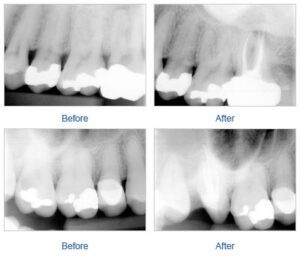
In a healthy vitalized tooth, entering the apex of the root are the blood vessels bringing nutrients that support any repairing function that the tooth needed and nerve bundle that provides the warning mechanism to protect the tooth i.e. too cold, too hot, too hard etcetera.
Devitalization of a tooth describes a loss of nutrients and sensory support for the tooth. This condition can be caused by many etiologies:
- Gross decay, which encroaches on the pulp or nerve/blood vessels chamber.
- Extensive history of restorations on the tooth can lead to devitalization.
- History of traumatic injury to the tooth can lead to devitalization many years from the date of occurrence.
- Some orthodontic movements can result in the devitalization of the tooth.
- Sudden traumatic injury that causes the exposure of nerve/blood vessels of the pulp chamber of the tooth.
- Improper over-brushing causes severe abrasion which leads to devitalization. Root exposures as a result of periodontal diseases.
- Other rare oral pathologies can also lead to tooth devitalization.
The process of devitalization, in most cases, will be accompanied by increasing levels of pain and can reach excruciating levels. However, some occur without any symptoms and the only signs may be the gradual darker change in color of the tooth and or a small pimple on the gum of the affected tooth.
Root Canal Therapy is performed under strong anesthesia, is virtually painless and, in most cases, provides immediate and long-lasting relief from recurring pain.
First, the decay is removed and an opening into the pulp chamber is created. Using very special instruments the pulp, including the nerve, is removed. The abscess is reduced or removed and the canals are cleaned. Since the nerve and infection are gone, you should have little further pain or discomfort.
Depending on which technique best fit your needs, the tooth may be left open to let the infection drain, medication may be temporarily placed to reduce some lingering infection, or the pulp chamber may be permanently filled with an inert material, usually gutta-percha. The tooth is then sealed to prevent bacteria from reentering the tooth.
Because a root canal-filled tooth becomes drier and brittle over time, a crown is recommended to cover the tooth to protect it from breaking. Root canal therapy has a high success rate, but occasionally a tooth must be retreated, surgically treated, or extracted if the infection can’t be brought under control.
A tooth is a part of your body, like your finger or toe or ear, and should not be removed without careful thought and consideration. That is why we believe in saving teeth through RCT and extraction only as the last resource.
Left alone, tooth devitalization will lead to an abscess around the root tip. This abscess will slowly destroy the surrounding bone of the root. When symptoms are subclinical, the only way to diagnose the problem is through a periapical radiograph and pulpal test.
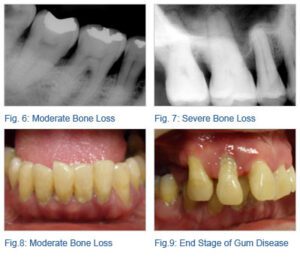 Periodontal Disease begins with the inflammation of the gum tissue. This irritation of the gum is called gingivitis and is caused by bacteria that are left on the teeth and under the gums after improper or ineffective brushing and flossing. If you have red, swollen or tender gums or if your gums bleed slightly with brushing, you might have beginning periodontal disease: gingivitis.
Periodontal Disease begins with the inflammation of the gum tissue. This irritation of the gum is called gingivitis and is caused by bacteria that are left on the teeth and under the gums after improper or ineffective brushing and flossing. If you have red, swollen or tender gums or if your gums bleed slightly with brushing, you might have beginning periodontal disease: gingivitis.
Dental plaque-induced gingival diseases include:
- Gingivitis associated with dental plaque only;
- Gingival diseases modified by systemic factors (the endocrine system, hematologic diseases);
- Gingival diseases modified by medications (phenytoin, an anticonvulsant, cyclosporine, an immunosuppressant, some calcium channel blockers);
- Gingival diseases modified by malnutrition.
Gingivitis can be successfully reverse by brushing and flossing twice a day with fluoride toothpaste and mitigating other contributing factors. By removing the bacteria in the sticky plaque on the teeth you remove the source of the problem and your gum will slowly heal.
Non-plaque-induced gingival lesions are associated with a broad scope of disorders:
- Gingival diseases of specific bacterial origin;
- Gingival diseases of viral origin;
- Gingival diseases of fungal origin;
- Gingival lesions of genetic origin;
- Gingival manifestations of systemic conditions;
- Traumatic lesions;
- Foreign body reactions.
When gingivitis is not reversed the disease will progress to the first stage of periodontitis. Periodontitis is characterized primarily by gum inflammation, clinical attachment loss, bone loss, and periodontal pocketing. Periodontitis is initiated and sustained by bacterial plaque, but host defense mechanisms play an integral role in its progression.

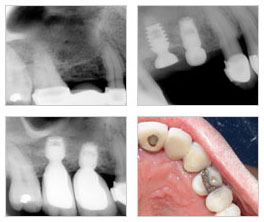
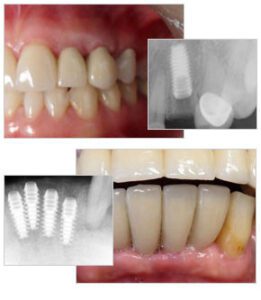
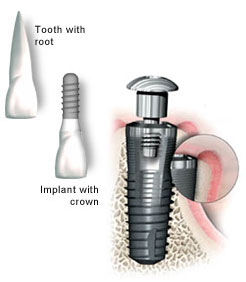
Quality of life can diminish for the millions of adults who suffer tooth loss. If you are missing one or more teeth and wish to eat your favorite foods, increase your chewing ability, and improve your appearance, speech, and self-esteem, then you are a candidate for dental implants.
Dental implants offer an excellent alternative to the limitations of conventional crowns, bridges, root canals, and dentures. Furthermore, dental implants can be used to stop alveolar bone loss which, in turn, slow the aging process, improve the immune system, and stop facial changes.
Before After


Before After
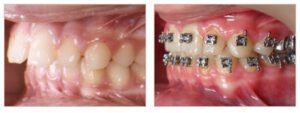
Orthodontics is a dental specialty that deals with the diagnoses, prevention, and correction of misaligned teeth and jaws. If left uncorrected, crooked teeth and misaligned bites can lead to abnormal function, headaches, sore jaw muscles, fractured teeth, and even tooth decay overtime.
Besides these negative physiological impacts, one cannot overstate the negative psychological impacts. Additionally, contrary to popular belief, age is not a limiting factor in getting orthodontic treatment.
We provide both orthodontic treatment modalities: braces and aligners. Braces involve brackets and wires. Aligners are clear appliances that cover the teeth.
Depending on the dental health profile and the severity of the misalignment, orthodontic treatment can be started early, around 8 years of age, when all four permanent molars and the front teeth have fully erupted, or, in our practice, as late as 78 years of age.
Braces and aligners are not just for teenagers. In fact, over ONE MILLION North Americans over the age of 18 have orthodontic appliances.
Parents, here is your chance to make a huge positive impact on your children’s dental health. You can help your children:
- Prevent dental decay.
- Avoid suffering from a toothache or dental abscess.
- Avoid early tooth loss which not only causes loss of function but could potentially lead to the development of misalignment of permanent teeth.
- Eliminate orofacial muscle habits known to cause malocclusion such as digital sucking.
- Prevent certain permanent discoloration of your child’s primary and permanent teeth.
Dental care for your child can be looked at in stages but keep in mind that it is a continuum and not mutually exclusive.
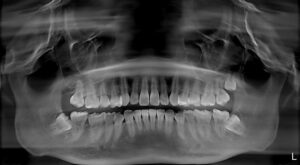

In our practice, oral surgery includes simple extractions of unsalvageable teeth, surgical extractions (for badly decayed teeth), and surgical extractions of impacted third molars (wisdom teeth).
All extractions are performed under local anesthetic and, if necessary, oral sedation. We also provide tissue and bone regeneration therapies in conjunction or preparation for esthetic restorations or implant placement.
